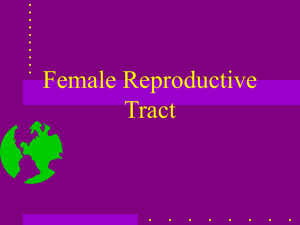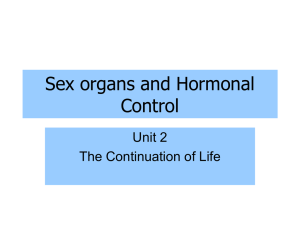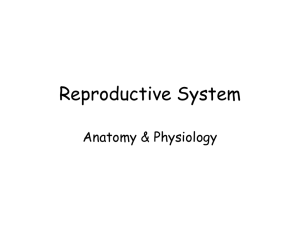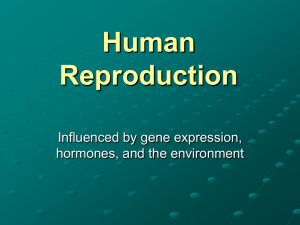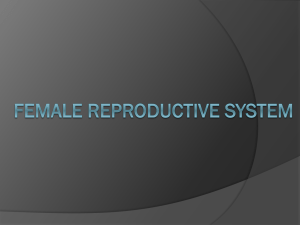Reproductive System Study Guide WITH ANSWERS To use this
advertisement
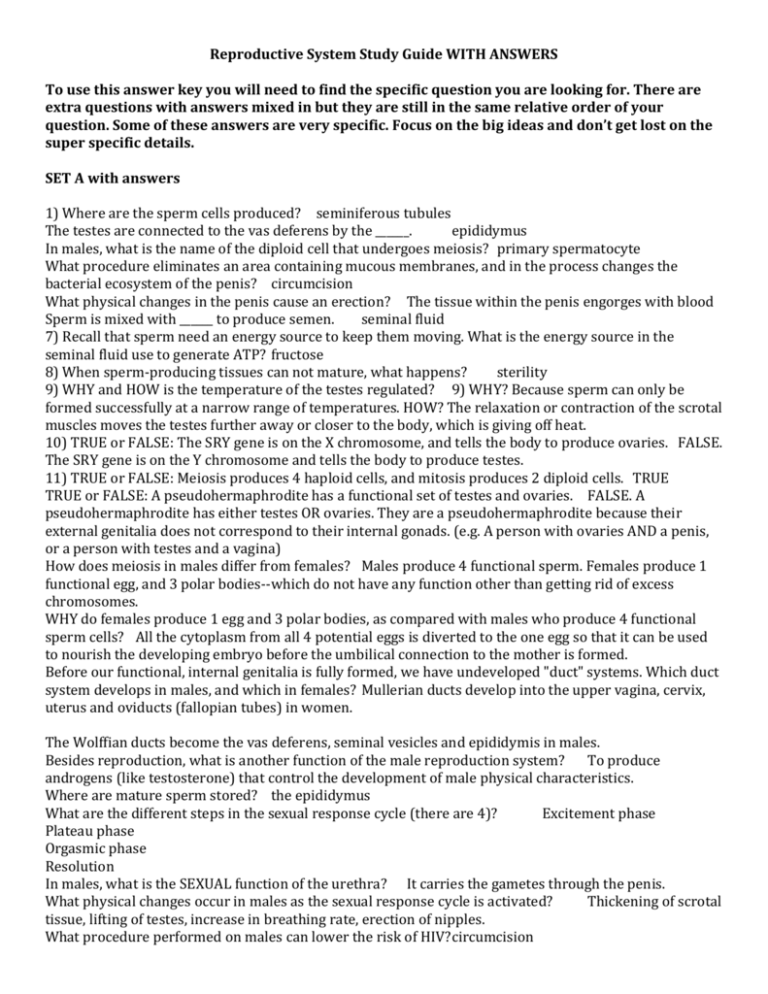
Reproductive System Study Guide WITH ANSWERS To use this answer key you will need to find the specific question you are looking for. There are extra questions with answers mixed in but they are still in the same relative order of your question. Some of these answers are very specific. Focus on the big ideas and don’t get lost on the super specific details. SET A with answers 1) Where are the sperm cells produced? seminiferous tubules The testes are connected to the vas deferens by the ______. epididymus In males, what is the name of the diploid cell that undergoes meiosis? primary spermatocyte What procedure eliminates an area containing mucous membranes, and in the process changes the bacterial ecosystem of the penis? circumcision What physical changes in the penis cause an erection? The tissue within the penis engorges with blood Sperm is mixed with ______ to produce semen. seminal fluid 7) Recall that sperm need an energy source to keep them moving. What is the energy source in the seminal fluid use to generate ATP? fructose 8) When sperm-producing tissues can not mature, what happens? sterility 9) WHY and HOW is the temperature of the testes regulated? 9) WHY? Because sperm can only be formed successfully at a narrow range of temperatures. HOW? The relaxation or contraction of the scrotal muscles moves the testes further away or closer to the body, which is giving off heat. 10) TRUE or FALSE: The SRY gene is on the X chromosome, and tells the body to produce ovaries. FALSE. The SRY gene is on the Y chromosome and tells the body to produce testes. 11) TRUE or FALSE: Meiosis produces 4 haploid cells, and mitosis produces 2 diploid cells. TRUE TRUE or FALSE: A pseudohermaphrodite has a functional set of testes and ovaries. FALSE. A pseudohermaphrodite has either testes OR ovaries. They are a pseudohermaphrodite because their external genitalia does not correspond to their internal gonads. (e.g. A person with ovaries AND a penis, or a person with testes and a vagina) How does meiosis in males differ from females? Males produce 4 functional sperm. Females produce 1 functional egg, and 3 polar bodies--which do not have any function other than getting rid of excess chromosomes. WHY do females produce 1 egg and 3 polar bodies, as compared with males who produce 4 functional sperm cells? All the cytoplasm from all 4 potential eggs is diverted to the one egg so that it can be used to nourish the developing embryo before the umbilical connection to the mother is formed. Before our functional, internal genitalia is fully formed, we have undeveloped "duct" systems. Which duct system develops in males, and which in females? Mullerian ducts develop into the upper vagina, cervix, uterus and oviducts (fallopian tubes) in women. The Wolffian ducts become the vas deferens, seminal vesicles and epididymis in males. Besides reproduction, what is another function of the male reproduction system? To produce androgens (like testosterone) that control the development of male physical characteristics. Where are mature sperm stored? the epididymus What are the different steps in the sexual response cycle (there are 4)? Excitement phase Plateau phase Orgasmic phase Resolution In males, what is the SEXUAL function of the urethra? It carries the gametes through the penis. What physical changes occur in males as the sexual response cycle is activated? Thickening of scrotal tissue, lifting of testes, increase in breathing rate, erection of nipples. What procedure performed on males can lower the risk of HIV? circumcision In the womb, at how many weeks post-conception do male sexual characteristics start to develop? About 8 weeks. What are the 2 types of gonads? Ovaries in females, testes in males. Name the structures of the male reproductive system in the order in which sperm passes through them. Start with the structure in which the sperm are made. Seminiferous tubules (sperm creation), epididymus (sperm storage), vas deferens, seminal vessicle, prostate, urethra What are the main parts of the sperm, and the function of each?1) An ovoid head - contains genetic information 2) Acrosome - interacts with egg membrane to initiate events of fertilization 3) Midpiece - contains mitochondria that generate ATP so sperm can have energy to move around 4) Tail - the whip-like tail beats back and forth to move the sperm. Through what structure do the testes descend (drop) into the scrotum? inguinal canal What is the cap-like structure of a mature sperm called? acrosome What are some causes of sterility? castration, impotence, sexually transmitted disesase, high production of abnormal sperm What is the technical term for the inability to sustain an erection (HINT: it is an alternate term to erectile dysfunction). impotence SET B with answers How is the scrotum affected by temperature? When it is cold, testes are pulled closer to the pelvic floor and the warmth of the body wall, and the scrotum becomes shorter and heavily wrinkled, reducing surface area and increasing its thickness to reduce heat loss. When warm, the scrotal skin is flaccid and loose to increase the surface area for cooling (sweating) and the testes hang lower, away from body trunk. What is the path of the sperm from the testes to penis? Made in the seminiferous tubules, straight tubule, rete testis, efferent ductules, epididymis (head, body, tail), ductus deferens (through spermatic cord), ampulla of ductus deferens joins with duct of seminal vesicle to form short ejaculatory duct, then enters prostate emptying into urethra (preprostatic, prostatic, membranous, spongy - receives secretions from bulbourethral glands) What are the two tunics of the testes? Outer tunic is two-layered tunica vaginalis derived from out pocketing of peritoneum. Deep to this serous layer is tunica albuginea which is the fibrous capsule of the testis. What structure helps in moving the sperm out of the testes? Smooth muscle-like myoid cells which are found in surrounding in each seminiferous tubules in three to five layers. They contract rhythmically, helping to squeeze sperm and testicular fluids through tubules and out of testes What is the spermatic cord? Nerve fibres, blood vessels and lymphatics enclosed in connective tissue sheath connecting testes to abdominal wall and passes through inguinal canal What is the function of the epididymis? Immature, nearly nonmotile sperm leave the testis are moved slowly along duct of the epididymis through fluid that contains a number of antimicrobial proteins (ex. beta-defensins). As they move (bout 20 days) they gain ability to swim. Some pseudostratified epithelial cells have microvilli allowing the absorption of excess testicular fluid and pass nutrients to many sperm. What epithelia makes the epididymis and ductus deferens? Pseudostratified epithelial: single layer of cell of varying heights thats main function is secretion What are the four structures of the urethra? Preprostatic urethra: approx. 1cm and extends form base of bladder to prostate Prostatic urethra: 3-4 cm long and surrounded by prostate gland Membraneous urethra: narrow and passes through deep perineal pouch Spongy urethra: longest portion and surrounded by erectile tissue What is the function of seminal vesicles, prostate and bulbourethral glands? Seminal vesicles: yellowish alkaline fluid containing fructose, ascorbic acid, coagulating enzyme and protaglandins which enhance sperm motility/ fertilising ability Prostatic gland: role in activating sperm and accounts for 1/3 of semen volume. Milky, slightly acidic fluid that contains citrate, several enzymes and prostate-specific antigen Bulbourethral glands: thick clear mucus. Acts to drain into spongy urethra and provide lubrication for glans penis during sexual excitement and to neutralise traces of acidic urine in urethra before ejaculation What is occurring in spermatogenesis before puberty? Before puberty, spermatogonia is being continuously being divided by mitosis and their daughter cells become spermatogonia Name the stages of spermatogenesis? 1. Mitosis of Spermatogonia to form type A (remain at germ cell line) and type B cells (pushed towards lumen, where it becomes primary spermatocyte. (Diploid) 2. Primary spermatocyte undergo meiosis I to form secondary spermatocyte (haploid) 3. Secondary spermatocyte undergo meiosis II to form early spermatids (haploid) 4. Early spermatids - late spermatids undergo spermiogensis where the small round cells, with large spherical nuclei elongates, shed excess cytoplasmic baggage and forms tail to end result in spermatozoon What are the four parts of the uterine tubes? isthmus, ampulla, infundibulum, fimbriae What are sertoli cells? Throughout spermatogenesis, descendants of same spermatogonium remain closely attached to another by cytoplasmic bridges. Surrounded by non-replicating supporting cells called sertoli cells which extend from basal lamina to lumen of tubule. They help developing sperm through spermatogenesis. What do FSH and LH bind to and what are their functions in male? FSH binds to sterol cells to release ABP to keep conc. of testosterone in vicinity of spermatogenic cells high. LH binds to interstitial cells in soft connective tissue surrounding seminiferous tubules, prodding them to secrete testosterone. What are the several ligaments that the ovary is supported by? Ovarian ligament anchors the ovary medially to uterus. Suspensory ligament anchors it laterally to pelvic wall Mesovarium suspends it in between Suspensory ligament and mesovarium are part of broad ligament, a peritoneal fold that tents over uterus and supports uterine tubes, uterus, vagina. Ovarian ligaments are enclosed by broad ligament. What is happening to the uterine tubes at time of ovulation? Uterine tubes perform complex movements to capture oocytes. It bends to drape over ovary while fimbraie stiffen and sweep the ovarian surface. The beating cilia on fimbriae then create currents in peritoneal fluid that tend to carry an oocyte into uterine tubes. Uterine tubes have sheets of smooth muscle, and this, highly folded mucosa contains both ciliated and conciliated cells which oocyte is carried by combination of muscular peristalsis and beating of cilia. Which ligaments support the uterus? Supported laterally by mesometrium portion of broad ligament Lateral cervical ligaments extend from cervix and vagina to lateral walls of pelvis, and paired uterosacral ligaments secure uterus to sacrum posteriorly Round ligaments bound uterus to interior body wall Ligaments allow uterus a good deal of mobility, and its position changes as rectum and bladder fill and empty. What are the two layers in the endometrium and what function do they have?Two chief strata: statum functionalis: undergoes cyclic changes in response to blood levels of ovarian hormones and is shed during menstruation stratum basalis: forms new functionalis after menstruation ends. Unresponsive to ovarian hormones What are the three layers of the uterine wall? Perimetrium: outermost serous layer Myometrium: bulky middle layer, composed of interlacing bundles of smooth muscle Endometrium: mucosal lining of uterine cavity What are the arteries in the uterine wall? uterine arteries arise from internal iliacs in pelvis, ascend alongside of uterus, and send branches into uterine wall. These branches break up into several arcuate arteries within myometrium then send radial branches where straight arteries in status basalis is and spiral arteries in stratum functionalis Before ovulation, what phase is the oocyte in and what phase is it after ovulation before fertilisation? Propase I and then Metaphase II What are the two phases in oogensis? Follicular Phase: growth of follicle cells Luteal Phase: activity of corpus luteum Brief overview of oogensis primordial follicles, primary follicles, secondary follicles, late secondary follicles, mature vesicular follicle, corpus luteum, ovulation, gransulosa cells, theca cells, zona pellucida, antrum, prophase 1, metaphase 2, polar body What is secondary follicle? Early secondary follicle: follicular cells proliferate forming stratified epithelium around oocyte and cells called granusola cells which there are gap junctions from cells to oocyte for nutrients etc. Late secondary follicle: connective tissue condense around follicle forming theca folliculi. Theca folliculi and granusola cells communicate to produce estrogen. Oocyte secretes glycoprotein-rich substance that forms thick transparent extracellular layer called zona pellucida How is oestrogen produced in the secondary follicle? Inner theca cells produce androgens, which the granulosa cells convert to oestrogen What is the function of the corpus luteum? To produce progesteron and some oestrogen. Progesterone is used to maintain stratum functionalis and thus is essential during pregnancy What events happen after the LH surge? Stimulates primary oocyte of dominant follicle to complete first meiotic division, forming secondary oocyte that continues to metaphase II. It increases local vascular permeability, stimulates release of prostaglandins, and triggers an inflammatory response that promotes the release of metalloproteinase enzymes that help weaken the ovary wall. It results in blood restriction and then ovulation. Where is inhibin released from in the ovarian cycle? Inhibin is released by the granusola cells during the rising estrogen levels and it is also released by the corpus luteum Wen are progesterone levels at their highest? In the secretory phase where it is produced by the corpus luteum which maintains the stratum functionalis What causes the rapid oestrogen decline after ovulation? LIkely because of the damage to the dominant estrogen-secreting follicle during ovulation (gransuloa cells) What is the menstrual cycle? A series of cyclic changes that the uterine endometrium goes through each month as it responds to the waxing and waning of ovarian hormones in the blood When are oestrogen levels highest? Estrogen levels are at the highest around before ovulation where it creates negative feedback to hypothalamus but intensifying the effect of FSH on follicle maturation. High levels of oestrogen triggers LH surge. What is the correlation between ovarian cycle, ovarian hormone levels and uterine cycle? Menstrual and proliferative phase occurs before ovulation and secretory phase is after. Progesterone levels are highest in secretory phase as it is produced by the corpus luteum after ovulation where LH and FSH are inhibited. However, LH and FSH are highest at ovulation where it is triggered by the the high oestrogen levels right before ovulation. What is the bulbospongisosus muscle? It assists in helping expel last drop of urine, assist in erection by pushing blood into the body of penis and compressing outflowing veins. Forms a sphincter that compresses the bulb of penis and corpus spongiosum thereby aiding in emptying the spongy urethra of urine and sperm. Helps in erection - anterior fibres encircle the most proximal part of body of pens is and increase pressure on the erectile tissue in root of pens is, impeding venous damage What is the ischiocavernosus muscle in male? It maintains erection of penis by compressing outflowing veins and pushing blood into the body of penis. they surround the crura (proximal ends of the corpus caverosus at root of penis). Each muscle forces blood from the cavernous spaces in the crura into the penis. Deep dorsal vein also compressed by these muscles. Where is the uterus located? It is positioned between rectum and bladder. The bladder is anterior and the rectum is posterior. It often tilts forward (anteverted/anteflexed) What is recto-uterine pouch? It part of peritoneal cavity that lies between the rectum and the posterior wall of the uterus What is the vesico-uterine pouch? It is part of the peritoneal cavity that lies between the bladder and the anterior wall of uterus. What are the two main ligaments suspended by the ovaries? Suspensory ligament: connects to the lateral wall of pelvis. It also conveys the ovarian vessels and lymphatics and nerves and constitutes the lateral part of the mesovarium of the broad ligament Ovarian ligament: attaches the ovary to the uterus which also runs into the mesovarium of the broad ligament What is anteverted and ante flexed? Anterverted: when the inferior part of uterus inclines anteriorly (tips forward towards the bladder). This is most the most common position however some women have a retroverted uterus which is tipped towards the posterior Anteflexed: fundus is pointing forward relative to the cervix What musculature and ligaments support the uterus? A. passive support from bladder: uterus is anteverted and so rests over bladder B. Ligaments: Broad ligament (peritoneum): support the uterus laterally; peritoneal folds over the uterus and holds it to the lateral wall and floor of pelvis. Lateral cervical ligaments: connects the cervix of the vagina to the lateral pelvic wall Uterosacral ligaments: extends from sides of cervix to the middle of sacrum Round ligament: binds to uterus to the anterior abdominal wall, runs through the inguinal canal to fuse with fibres in labia majora C. pelvic floor: pelvic diaphragm is dynamic support What are the two compartments in the testis? Seminiferous tubules (produce sperm) Interlobular tissue (synthesis and secrete androgens) What epithelia makes up the epididymis and uterus? Tall columnar What epithelia makes up the vas deferens? Pseudostratified columnar cell What structures of that pathway and how it aids the sperm movement? Ciliated epithelium - aids movement and directional flow (plus steriocilia of vas deferens) Ducts supported by smooth muscle (movement) Pseudostratification (efferent ductules, Vas deferenes/ ejaculatory duct) for absorption of fluid and phagocytic processes How long does it take for one cycle of meiosis take to produce sperm? 70 days What makes up the myometrium? They have three indistinct layer of smooth muscle, collagen and elastic fibres What is the endometrium? Inner, thick mucosa Consists of tubular glands extending from surface into stroma Stratum functionalis: responsive to hormones and undergoes monthly style of proliferation, secretion, necrosis and shedding Stratum basalis: not shed during menstruation - provides a cellular reserve from which a new functional layer develops Hormone sensitive What are the four layers to the vagina? 1. stratified squamous epithelial mucosa (non-keratinising) 2. lamina propria - rich in elastic fibres and blood vessels 3. fibromuscular layer - ill defined bundles of smooth muscle 4. adventitia - fibrocollagenous tissue with thick elastic fibres, nerves, large blood vessels and clumps of ganglion cells What are the bones that make up the walls of the pelvic cavity? pubic symphysis pubic tubercle ischiopubic ramus ischial tuberosity obturator foramen ischial spine coccyx anterir What muscles make up the pelvic wall? obturator internus piriformis What are the three muscles that make up the levator ani? pubococcygeus puborectalis illiococcygeus What muscles make up the pelvic floor? pelvic diaphragm and anteriorly the perineal membrane and deep perineal pouch What is the function of the levator ani muscles? ... The cervial canal has two means of communicating with the vagina and the uterus. What are they? It communicates with the vagina via the external os and the cavity of the uterine body through the internal os. What are the different structure reflects the different functions in the reproductive process? Spermatozoa: compact, streamlined, highly-motile Oocytes: large, nutrient/protein-rich cells What is the ploidy and DNA copy number? ploidy: number of sets of chromosomes within a cell or organism DNA copy number: no. of strands of homologous strands What are the differences between male and female gametogenesis? Male (spermatogenesis): unlimited: - puberty to death - spermatogonia replenished via mitosis continuous: - continuous meiosis - continuous production symmetrical division: - 4 functional gametes Female (oogensis): limited: puberty to menopause and oogonia is not replenished discontinuous: interrupted meiosis and monthly production asymmetric division: 1 functional gamete Which gametes determine sex? The male gametes will bear either X or Y where as in female gametes they will only have X Describe the different stages of follicle development. Primordial follicle: one layer of squamous-like follicle cells surround oocyte Primary Follicle: one layer of cuboidal or columnar-type follicle cells surround oocyte Secondary follicle: two or more layers of granulosa cells surround the oocyte Late secondary follicle: small fluid filled spaces appear between granulosa cells. Theca and zone visible Vesicular/tertiary follicle: a central fluid filled cavity(antrum) and corona radiata form Corpus luteum: post ovulatory luteinized follicle What hormones are involved in the ovarian cycle? GnRH: stimulates secretion of LH and FSH Luteinizing hormone (LH): stimulates secretions of androgens Follicle stimulating hormone (FSH): supports conversion of androgens to oestrogens Oestrogen: - negatively/positively regulates LH and FSH release - stimulates endometrium as well as primary and secondary sex characteristics Inhibin: - inhibits FSH Progesterone: - negatively regulates LH and FSH release - stimaultes endometrium as well as primary and secondary sex characteristics What is occurring the follicular phase? After puberty, primordial follicles spontaneously activate Growth of a small cohort of these follicles is accelerated during the follicular phase by FSH and LH Growing follicles secrete oestrogen which inhibit FSH Follicle selection and atresia results in the maturation of one dominant follicle per cycle At ovulation, this dominant pre-ovulatory (graafian) follicle reaches diameter of 2.5cm What happens during ovulation? -Ovulation occurs 14 days after the onset of menstruation - sustained, elevated oestrogen from the dominant follicle triggers an LH surge: - resumption of meiosis I in oocyte and then arrest in metaphase II - final follicle growth, weakening of follicle wall and ovulation - follicle wall rapidly swells, ruptures and releases the oocyte surrounded by corona radiata - shortly after ovulation, oestrogen levels decline What happens in the luteal phase? - after ovulation, LH stimulates granulosa and theca cells of ruptured follicle to rapidly differentiate into lutein cells to form corpus luteum - CL: secretes large amounts of oestrogen and progesterone - in non-pregnant cycle, CL degenerates after 10 days after ovulation - CL regression = decrease in oestrogen and progesterone while an increase in folliculogenesis - eventually forms residual scar on ovary called corpus albicans What are the three phases of the uterine cycle? menstrual: day 1-5 (shedding of the functional endometrium layer) proliferative: day 6-14 (rebuilding of functional layer) secretory: day 15-28 (enrichment of blood supply and nutrient secretion by endometrial glands) What arteries are found in the myometrium layer of the uterus? arcuate arteries Which follicles can be classified histologically as pre-antral and antral? Preantral: primordial, primary, secondary, late secondary Antral: vesicular - tertiary, mature vesicular = graafian = preovulatory How long does it take for a primordial follicle to mature into a mature ovulatory follicle? 100-110 days What causes the peak of LH on about day 14 of the cycle? ... What is the possible function of the FSH peak about day 5 of the cycle? recruitment of follicle growth (cells and fluid accumulation) responsible for follicle growth and maturation targeting granulosa cells The function of the FSH peak on about day 14 is not entirely clear. What causes this peak and what do you think possible functions might be? - surge of GnRH - burst of follicle growth/expansion Is the primary oocyte haploid or diploid? diploid Is the secondary oocyte haploid or diploid? haploid What hormone largely influences the proliferative phase of the cycle? estrogen What is the major constituent of the uterine secretions during the secretory phase? glycogen How is the acidic vaginal environment maintained? lactobacillus produces lactic acid to produce natural defence against irritations, itching, soreness and infection What are the two cell types involved in oestrogen production by the ovarian follicle? Granulosa cells and thecal cells. As follicle enlarges by FSH, LH prods theca cells to produce androgens where the hormones diffuse through basement membrane where they are converted to oestrogen by granulosa cells. What are the sources of inhibit during the cycle? grandulosa cells and corpus leutum to exert a negative feedback on FSH What is the zona pellucida, when is it formed and where is it found? It is a glycoprotein-rich substance forming transparent extracellular layer which accumulates between granulosa cells. It is formed early secondary follicle. What is atresia? It is the degeneration and reabsorption of ovarian follicle before it reaches maturity and ruptures What is the chromosome status of the following: 1. spermatozoa 2. Type A spermatogonia 3. Type B spermatogonia 4. spermatids 5. primary spermatocytes 6. secondary spermatocytes 1. haploid 2. diploid 3. diploid 4. haploid 5. diploid 6. hapoid What is the blood-testis barrier? It is formed by the tight intracellular junctions between the sertoli cells in the seminiferous tubules. The barrier separates basal and adluminal compartments of seminiferous tubules. It enables seminiferous tubules to maintain somewhat different composition of fluid inside lumen. It protects spermatocytes, spermatids and spermatozoa from blood-borne toxic substances and circulating antibodies. Prevents byproducts of gametogensis from entering circulation lest they should stimulate an autoimmune reaction Which hormones are steroid and peptide? (GnRH, FSH and LH) Steroid Hormones (FSH and LH): nonpolar and can cross membranes to reach intracellular receptors Peptide Hormones (GnRH): water soluble, polar, cannot cross cell membrane and attacks to cell surface receptors Which hormone stimulates sertoli cells in the testis? FSH where it stimulates sertoli cells to release ABP and keep concentration of testosterone in vicinity high to simulate spermatogenesis Which hormone stimulates interstitial cells? LH where it stimulates interstitial cells to secrete testosterone What is the role of androgen binding protein? To keep the conc. of testosterone level high What is the function of inhibin in males? It is a barometer of normalcy of spermatogenesis What is the ischiocavernosus muscle and bulbospongiosus muscle? (corpora cavernosa and corpus spongiosum) Corpora Cavernosa: erectile bodies that make up the majority of the penis. Their attached ends form the crura of the penis. These crura are anchored to the pelvic arch by ischiocavernosus muscle. These tissue columns surround central artery which allows the tissues to become engorged with blood producing enlargement and stiffening of the penis. Corpus spongiosum: surround penile urethra. Tissue extends proximally to form the root and bulb of the penis. The bulb is anchored to perineal membrane by sheet-like muscle called bulbospongiosus muscle. The corpus spongiosum tissue functions to maintain the urethral opening during ejaculation.
